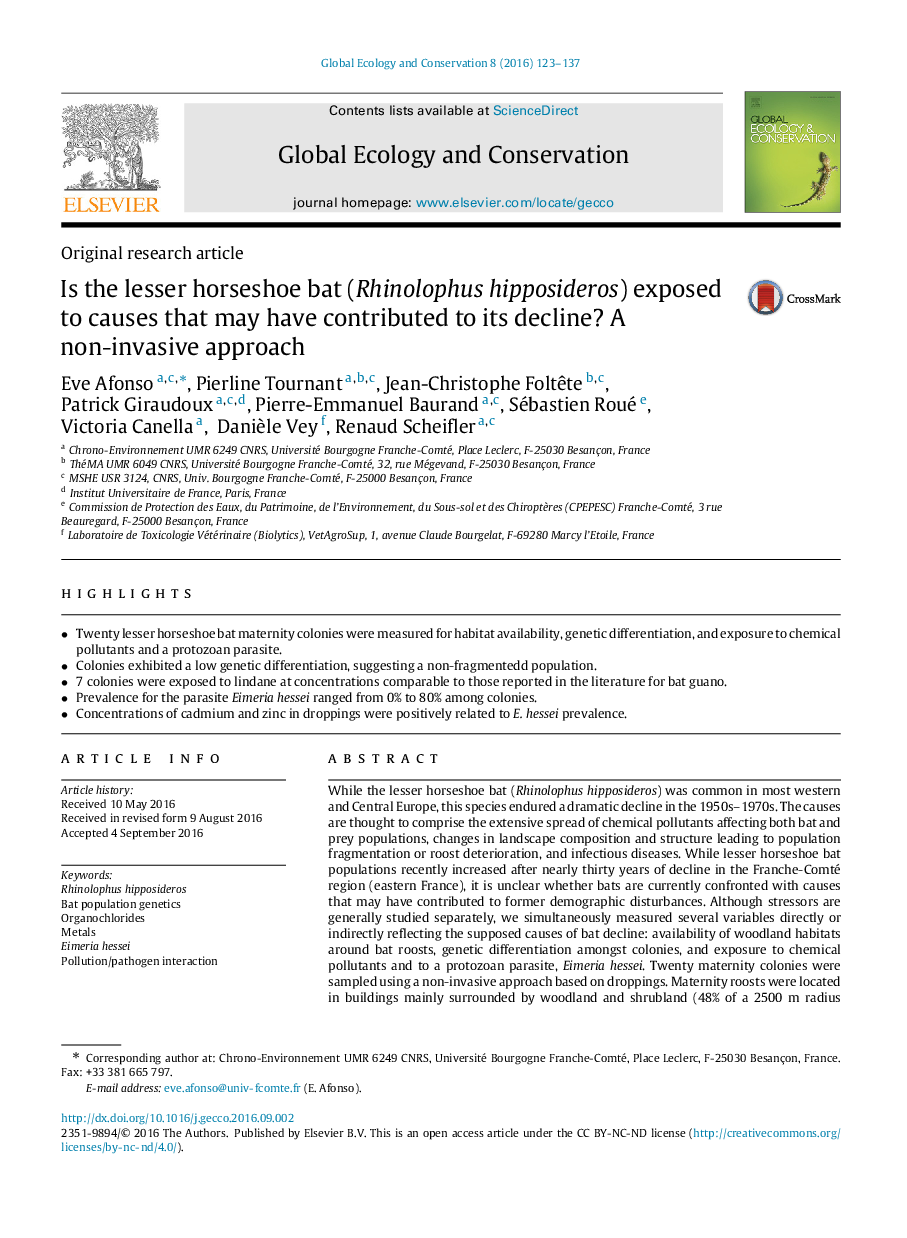| کد مقاله | کد نشریه | سال انتشار | مقاله انگلیسی | نسخه تمام متن |
|---|---|---|---|---|
| 4379439 | 1617659 | 2016 | 15 صفحه PDF | دانلود رایگان |
•
• Twenty lesser horseshoe bat maternity colonies were measured for habitat availability, genetic differentiation, and exposure to chemical pollutants and a protozoan parasite.
•
• Colonies exhibited a low genetic differentiation, suggesting a non-fragmentedd population.
•
• 7 colonies were exposed to lindane at concentrations comparable to those reported in the literature for bat guano.
•
• Prevalence for the parasite Eimeria hessei ranged from 0% to 80% among colonies.
•
• Concentrations of cadmium and zinc in droppings were positively related to E. hessei prevalence.
While the lesser horseshoe bat (Rhinolophus hipposideros) was common in most western and Central Europe, this species endured a dramatic decline in the 1950s–1970s. The causes are thought to comprise the extensive spread of chemical pollutants affecting both bat and prey populations, changes in landscape composition and structure leading to population fragmentation or roost deterioration, and infectious diseases. While lesser horseshoe bat populations recently increased after nearly thirty years of decline in the Franche-Comté region (eastern France), it is unclear whether bats are currently confronted with causes that may have contributed to former demographic disturbances. Although stressors are generally studied separately, we simultaneously measured several variables directly or indirectly reflecting the supposed causes of bat decline: availability of woodland habitats around bat roosts, genetic differentiation amongst colonies, and exposure to chemical pollutants and to a protozoan parasite, Eimeria hessei . Twenty maternity colonies were sampled using a non-invasive approach based on droppings. Maternity roosts were located in buildings mainly surrounded by woodland and shrubland (48% of a 2500 m radius buffer around the colonies), which are preferentially used by the lesser horseshoe bat as foraging areas. Low genetic differentiation (FST=0.023FST=0.023–0.028, D=0.076D=0.076–0.097) and no genetic clusters were found among the 20 sampled colonies, in which 449 individuals were distinguished over two sampling sessions (2010 and 2011). This suggests that no obvious physical barrier acts as a constraint with respect to gene flow, and we conclude that all individuals sampled belong to a unique non-fragmented population. Among the 66 chemical substances measured in bat droppings, the insecticides endosulfan alpha (0.035μg∕gdm) and lindane (from 0.013 to 0.112μg∕gdm) were the only organic compounds found at detectable concentrations in one and 7 colonies, respectively. Fourteen metals were measured in the guano. Metal concentrations were lower than or of the same order of magnitude as concentrations reported in bats in the literature. The overall faecal prevalence of EE. hessei was 42% (range: 0%–80%) and did not differ between the two sampling sessions. Faecal prevalence was not related to lindane concentrations in droppings. Despite the low concentrations of metals, a positive relationship was found between cadmium and zinc concentrations and E. hessei faecal prevalence. Although it is difficult to conclude on the risks of adverse effects due to the lack of both toxicological references and knowledge on E. hessei pathogenicity, this study stresses out the interest of systemic approaches in the study of ecology of wildlife species, especially via the investigation of multiple exposures.
Journal: Global Ecology and Conservation - Volume 8, October 2016, Pages 123–137
